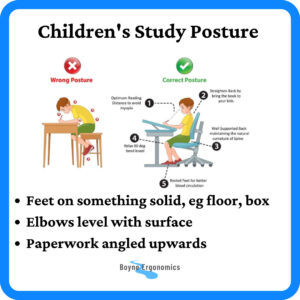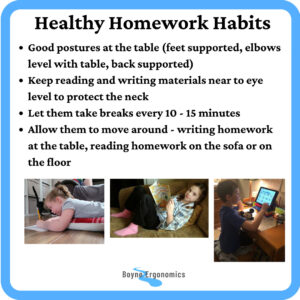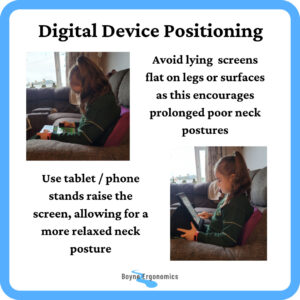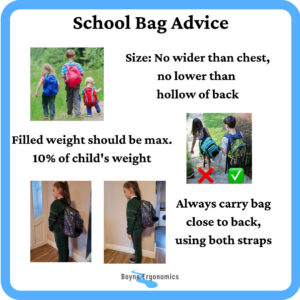Ergonomics and human factors is all about designing and optimising tasks, environments and equipment to promote musculoskeletal health and comfort. This applies not just to work settings, but also to the play and study environments of young people.
As we get back into the swing of the new school year, I feel it is important to highlight the steps we can take to reduce the risk of musculoskeletal discomfort and eye strain associated with homework and studying. This has become increasingly important, I feel, as the learning and leisure time for a lot of children has become more centred around the use of digital devices.
Why Is Children’s Ergonomics So Important?
Before I get into what we can do as caregivers to help encourage healthy musculoskeletal development in children and adolescents, it is so important to remember that children are not “little adults”. Their musculoskeletal systems are in the development stage, right up until the ages of 18-21, and as such they have different needs and can withstand different demands. Another factor that needs to be considered is cognitive development. The inner workings of the child and adolescent brain are not the same as the adult brain. This can impact all areas of cognition, as well as emotional regulation, impacting how children and adolescents take in and process information.
So why should we be paying attention, not only to what our young people are doing, but also how? Firstly, good ergonomic practices and habits will allow them to learn and play in comfort, with less risk of injury, in the short and long term.
Secondly, as young musculoskeletal systems develop, the bones are malleable and not fully fused and it is important that we encourage postures, movements and age appropriate loading to ensure optimal spinal alignment and muscle development. This will provide a solid musculoskeletal platform as children grow into adolescence and adulthood.
Finally, children and adolescents generally have shorter attention spans and can get easily distracted and bored with prolonged tasks, making it more difficult for them to take in information and complete tasks. It is important to pay attention to the child to see what tasks they struggle with more, to help you design homework time to optimise learning.
What Are The Risks Associated With Poor Ergonomics In Childhood?
When talking about poor ergonomics in childhood, what I am referring to is prolonged static postures, prolonged repetitive movements and prolonged adverse postures. You will notice a common thread in the three factors mentioned, PROLONGED!
- Static postures are not bad, we need to rest.
- Repetitive movements are not bad, we need to exercise the muscles.
- Adverse postures are not bad, we need to move and maintain joint range of motion.
Humans are not designed to be still, especially children. We need to both physically and mentally stimulated. Excessive and prolonged adverse postures, excessive repetitive movements and a sedentary lifestyle in childhood can impact the musculoskeletal system in three ways:
- Muscular issues stemming from poor muscular balance. This can be caused by prolonged sitting, prolonged use of mobile devices, prolonged forward leaning postures when completing school and homework.
- Structural issues caused by abnormal skeletal system development.
- Functional issues which occur when the changes to the musculoskeletal system impact joint integrity and functionality. This can lead to excessive wear and tear on the joints.
All of these combined can lead to poor posture and chronic pain, along with the other known side effects of sedentary behaviours, such as Type II Diabetes, cardiovascular issues, digestive issues, pulmonary issues and negative impact on mental and emotional wellbeing.
There is a wide range of research showing the impact of prolonged sedentary postures and adverse postures in young people.
Drza-Grabiec et al found that prolonged sitting in 11-13 year olds resulted in trunk asymmetry, scoliosis, and altered spinal curves.
Kjaer et al conducted an 8 year study tracking the reporting of low back, mid back and neck pain on children from 9 – 15 years of age. They found that among the 9 year olds, mid back pain was the most common complaint but this changed to low back pain when they reached 13 and 15 years of age.
One of the most comprehensive papers I have reviewed on this subject is by Schmidt et al (2021) in conjunction with EU-OSHA. This paper highlights the findings that approximately 30% of young people aged between 7-26.5 years of age are suffering ongoing musculoskeletal discomfort. The risk factors identified include physical factors such as weight and nutrition, lifestyle and poor postures, mental or psychosocial factors, socioeconomic factors, environmental factors, sports participation and individual factors.
When it comes to musculoskeletal discomfort among children and adolescents, those that are caused by physical and psychosocial risk factors are preventable.
So What Can We Do To Reduce The Risk Of Our Children Developing Musculoskeletal Issues?
Even with the complex and ever changing needs of children and adolescents, there are a number of ways we can optimise the musculoskeletal development of children and adolescents and reduce the risk of musculoskeletal pain.
Modelling Behaviours
The first thing we can all do is to model good ergonomic practices ourselves. Children do not do as we say, they do as we do! If we want to promote good postures and an active lifestyle, then we must practice it ourselves.
Engaging in an active lifestyle, avoiding prolonged use of mobile devices and modelling good ergonomic practices when using digital devices can go a long way to keeping you healthy and encouraging good habits in children.
Active Lifestyle
The American Heart Association reports that, despite the maximum recommended screen / TV time for children being 2 hours per day, 8 years old get an average of 8 hours of screen time per day, with this increasing to 11 hours per day for teenagers!
Considering time spent in school, time spent doing homework and time spent on devices / TV, children and adolescents can spend a large portion of their days in a sedentary sitting position.
The HSE recommends a minimum of 60 minutes of moderate to vigorous physical activity per day.
Limiting screen time and encouraging active play and physical activity will not only encourage healthy musculoskeletal development, but can also increase self-esteem and reduce the risk of back and neck discomfort associated with digital device use.
Seated Posture When Studying
Ideally, when undertaking school and homework, their seated posture should be similar to that of adult DSE users. Feet should be planted on a solid surface, with a 90o angle at the knees and hips, with back supported.

It is important to consider the furniture available for them to use. There are desks and chairs designed for use by children, including adjustable ranges that can grow with the child, and if you have the space available in the home then these are great tools to encourage appropriate supported postures.
The standard dining table and chair can of course be used but I would try to make sure that there is a box etc under their feet for stability and additional cushioning on the chair to shorten the seat pan and increase seated height.
For reading and writing work, a tilted surface can help improve page positioning, discouraging the rounded, slumped postures often displayed by children doing paper based work.
Tilt adjustable desks are available, and can be a great addition to schools and homes but are often not practical or affordable for a lot of homes. A writing slope is a great and practical alternative and is what I use with my own children.
I feel it is also important to remember that children are generally fidgety and are usually unable to remain seated for long periods of time, and rightly so! I try to encourage this seated posture when suitable for the task, but I also encourage them to change position and location for different tasks, e.g doing their reading on the sofa or do their colouring lying on their stomachs on the floor.

Digital Device Use
When using a laptop or tablet, if it is for more than 30 minutes, the device should be elevated
using a laptop stand or tablet stand. This is to reduce adverse postures of the neck and reduce the possibility of developing symptoms and poor posture associated with Tech Neck.
If they are completing tasks that require typing or clicking, the device should be connected to an external keyboard and mouse. I also recommend using a child size mouse as it is more suitable for smaller hands.
As with adults, it is important to limit the amount of prolonged device use. Utilise parental control timers on devices or countdown clocks to encourage breaks and movement to different activities.

Appropriate School Bag Selection and Use
As described in my blog post from June 2022, Selecting The Correct SchoolBag For Young Users, ensuring the schoolbag is the correct size, adequately supportive and adjustable, not too heavy for the user and worn correctly can help reduce the risk of adverse postures and musculoskeletal strain.

When it comes to children and adolescent posture and behavioural habits, there is a lot outside of our control, especially when it comes to the times spent in school. There we do not select the furniture, we do not influence the amount of time spent seated or the amount of activity breaks. However, by encouraging healthy active lifestyles, active learning, supported postures and appropriate digital device use we can help foster healthy musculoskeletal development into adulthood.
Sources
George C, Children’s Ergonomics, What Parents and Educators Should Know. Ergonomic Trends. https://ergonomictrends.com/children-ergonomics-overview
Drza-Grabiec et al (2015) Effect of the sitting position on the posture of children ages 11 – 13 years. https://pubmed.ncbi.nlm.nih.gov/24962297/
Kjaer et al (2011) Prevalence and tracking of back pain from childhood to adolescence. BMC Musculoskeletal Disorders. https://bmcmusculoskeletdisord.biomedcentral.com/articles/10.1186/1471-2474-12-98
Schmidt et al (2021) Musculoskeletal disorders among children and young people: prevalence, risk factors and preventative measures. EU-OSHA
Cooper, A The Importance of Posture and Positioning for Handwriting. Children’s Support by LifeWorks. https://childrensupportsolutions.com/the-importance-of-posture-and-positioning-for-handwriting/
CIEHF (2021) Healthy and Happy Home Learning https://ergonomics.org.uk/resource/healthy-and-happy-home-learning.html
Cornell University Ergonomics Web, Keeping Kids Healthy, https://ergo.human.cornell.edu/cukkhinfo.htm


